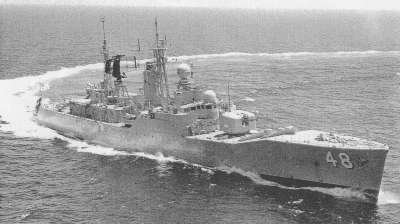- Author
- Gillett, Ross
- Subjects
- Ship design and development, Ship histories and stories
- Tags
-
- RAN Ships
- HMAS Derwent, HMAS Stuart II, HMAS Parramatta III, HMAS Swan III, HMAS Torrens II, HMAS Yarra III
- Publication
- December 2007 edition of the Naval Historical Review (all rights reserved)
On 28 October 1983, Swan earned the distinction of being the first and only RAN destroyer, as well as the largest and longest ship, to have been slipped in Fremantle. Swan was hauled onto the WA Public Works No. 1 Slipway as part of a two-week assisted maintenance period. The Federal Government had spent $375,000 upgrading the facility to take RAN ships and submarines up to 3 000 tonnes.

Stuart became the first of the River class to be homeported to HMAS Stirling in Western Australia, in January 1984. Later Swan was based there from December 1985, then Derwent from January, 1987 and finally, Torrens from September 1991.
The end of the River class era in the RAN began with the decommissioning of Yarra on 22 November 1985. Six years and seven months later she was towed from Sydney to be broken up in Bombay, India. Stuart, having completed a short refit in 1988, was attached to the Training Squadron. Highlight of the year was the Bi-centennial Naval Review and multinational naval exercises.
On 29 January 1990 Parramatta departed on her final overseas deployment, five months in South-East Asia, her third deployment in ten months. After almost 30 years in service Parramatta followed Yarra into reserve in January, 1991.
In 1990, Derwent conducted a five month deployment to SE Asia and after a refit, rejoined the Fleet minus her Seacat and Ikara missile systems, assuming the training role for junior seaman officers.
Stuart began her last overseas cruise on 31 January, 1991. This included exercises with the US and Philippines navies. She had steamed over 700,000 nautical miles in her 28 years of service. After her return to Australia she was paid off on 24 July 1991. As each of the destroyer escorts departed the Fleet, new Adelaide class guided missile frigates were commissioned.
In mid 1992 Swan began a major South East Asian deployment, taking her to Hong Kong, Korea, Indonesia, India, Exercise Starfish 92 in Malaysian waters, Thailand and finally Exercise Valiant Usher off the Western Australian coast in October.
During 1994 Derwent completed her 21st deployment to South East Asia since commissioning in 1964. However Derwent’s service to the Navy did not end with her paying off. Her final service was to be blown up in a series of ship survivability tests conducted by the Defence Science and Technology Organisation off the WA coast
Swan and Torrens remained in use as training vessels for their last years in service. During Exercise Tasman Link conducted in 1995, Swan became the first RAN ship to empty her magazine since the cruiser HMAS Perth in 1942. Swan fired 1,081 of her 4.5 inch shells. Swan was also the last of the Rivers to be equipped with a missile system when she was fitted with the marinised RBS‑70 surface to air missile launcher.
Swan becomes an artificial reef
Decommissioned at HMAS Stirling, Fleet Base West, on 13 September 1996, Swan was gifted to the WA State Government. She was scuttled in 30 metres of water at Geographe Bay, Busselton, in Western Australia. The sinking of the former warship was not a naval-controlled exercise, although divers from the Stirling-based Australian Clearance Diving Team Four were on hand to assist with the exercise and safety aspects of the operation.
The scuttling marked the end of almost two years work by the Geographe Bay Artificial Reef Society to prepare the hull as a ‘diver-friendly’ wreck, and four months effort by AUSCDT FOUR (LCDR McMillan) on the technical aspects of the explosive scuttling.
The challenge in creating a dive wreck was to have the hull arrive intact and upright on the bottom. Shaped linear charges created ten large diver-access holes, three metres below the water line. Six holes forward ensured the ship sank by the bow, driving her bows into the sand and stabilising the hull, while four holes aft (delayed in detonation by milliseconds) allowed the stern to settle more slowly to the seabed.
Watched by almost 20,000 spectators ashore and 300 spectator craft afloat, the sinking of Swan was a major event in the south-west. Fortunately, the shot was perfect. Three minutes and fifty two seconds later, Swan’s stern slid below the waves. Allowing the hull to settle for an hour, AUSCDT FOUR divers verified the charges were all safely detonated before handing Swan over to the Geographe Bay Artificial Reef Society. In pristine waters, she now makes a spectacular sight on the ocean floor. (Within two hours of sinking the ship was surrounded by schools of fish). Swan will generate an additional one million dollars per annum in the local region’s economy, attracting divers from all over the world.




